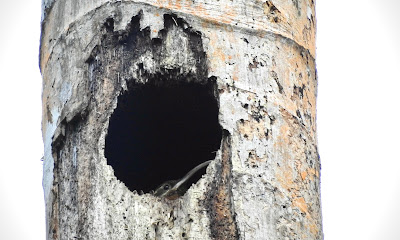AGOSTO 2022-1
Describing the nest of Crysothlypis salmoni
In 2019, I was in Malaysian Borneo studying birds in oil palm plantations. When the project ended, I took a bus to visit a renowned field station at the base of Mt Kinabalu, Borneo’s tallest mountain, where Tom Martin’s research lab studies the geographic variation in the life history traits of birds.
You can see Mt. Kinabalu from afar. After months of working in Borneo’s decimated lowlands, among endless rows of oil palm and dirt roads, the rock faces of Mt Kinabalu shone beautifully above lush, steep forest. I reached my hostel and immediately ascended the road towards the field station. During the hike, it struck me how many of the birds were banded. Montane endemics like Harpactes whiteheadi and Megalaima pulcherrima all wore color bands, as if the entire mountain’s bird community had resolved to partake in field research. Clearly, a dedicated and methodical team of researchers had been working here for years.
When I made it to the field station and met the crew, I immediately recognized one of the biologists. Before me stood Manuel “Manu” Sánchez, a Colombian biologist I hadn’t seen since working for Universidad Icesi in the National Park Farallones de Cali. It turns out Manu had been hired by the Martin lab for his masterful nest-searching skills, and so here we were, face to face, thousands of miles from where we first met in the western Andes.
We were equally surprised and happy to see each other. Then, without pausing Manu asked, “When are you going to publish your notes on C. salmoni?!” I laughed. I had been putting off finishing the paper for over two years, and with a tinge of embarrassment, promised him I would finally get it done. It’s true, running into Manu in Malaysia is probably what pushed me to publish my observations made in Colombia. Thanks Manu!
It’s now been years since I was in Colombia and took notes on the nest of C. salmoni for a paper that was published in the December 2021 issue of Wilson Journal of Ornithology. I’m glad we know a little more about this radiant, hyperactive tanager, and I learned so much from working on Gustavo’s team. Manu taught me how to handle and measure bats in the immense, insect-dripping nights of the Anchicayá rainforest. Harold Greeney, who was in Colombia searching for the nest of Ensifera ensifera for a TV show, offered us a crash-course in finding and filming nests, and guardedly worked on gorgeous drawings of Antpitta nests at the field station. Gustavo’s elevational gradient project allowed me to partake in tropical research for the first time. Writing and researching the C. salmoni nest description was an invaluable experience that showed me the work and worth of publishing natural history notes. Finally, the peer-review process allowed me to share these observations with the world, as so many other biologists have by working with Universidad Icesi. Yet, so much remains unknown.
The National Park Farallones de Cali hold incredible biodiversity, and it turns out the C. salmoni nest wasn’t the coolest nest I found while in Colombia. One day, mist-netting on the elevational gradient at the Icesi field station, I watched a Greater Scythebill (Drymotoxeres pucheranii) enter a hole in a Yarumo (Cecropia sp.) snag. Then again, and again. Qué chimba. The nest of D. pucheranii was not well described and little information exists about this beautiful, thinly distributed species. I told Gustavo about the nest and began day-dreaming about climbing the hollow, delicate trunk to take measurements. Then, two days later, while checking mist-nets nearby, I heard a massive crash. The Yarumo snag had fallen to the ground and the D. pucheranii nest cavity was shattered on impact. The parents hovered above the jumble of their broken efforts, calling in alarm. While the nest is long gone, this photo of the adult tucked into the cavity lives on:
Recently, it looks like Greeney’s team has found a D. pucheranni nest in Ecuador, and I imagine that at the Icesi field station in Colombia, young biologists are waking at dawn, entering the forest, and learning new things about the birds there every day. I hope the knowledge generated by Icesi’s research protects the forest from destruction, and that its green magic feeds the hearts and senses of the biologists that work there, like it did mine. Thank you again Icesi, Gustavo, Manu, and many others for the incredible opportunity to come work with you in Colombia.
Escrito por Jason Gregg






Comments
Post a Comment